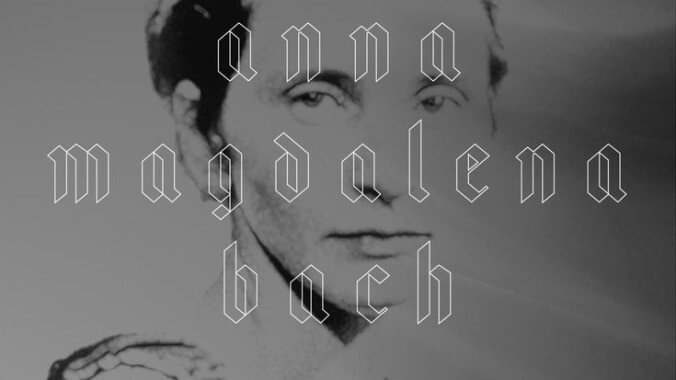The strangest and most uncompromising of all musician biopics, Jean-Marie Straub and Danièle Huillet’s 1968 debut feature, The Chronicle Of Anna Magdalena Bach disregards most conventions of costume drama to ask some very human questions about history, what it takes to be an artist, and what movies can tell us about ourselves. The film, which is touring in a new digital restoration for its 50th anniversary, is a classic of European art cinema, a minimalist manifesto, and the easiest entry point into the challenging anti-Masterpiece Theatre of Straub and Huillet, a husband-wife duo who co-directed more than 30 films (all of which can be loosely categorized as “adaptations”) before Huillet’s death in 2006. It may also be a self-portrait and a political statement; what matters is that it tests our preconceptions about historical narratives and dramatic involvement, and in doing so, hits at some truth about time.
J.S. Bach, the greatest of the Baroque composers, is played by the renowned Dutch harpsichordist and organist Gustav Leonhardt, who looks nothing like the man. He is tall, thin, with a longish face. Christiane Lang-Drewanz plays Bach’s second wife, Anna Magdalena, of whom no portraits survive; she is also the narrator, reading a fictitious journal inspired by the couple’s letters. But what passes for the narrative line of Chronicle Of Anna Magdalena Bach is fragmentary. We are shown close-ups of Bach’s real, smudgy, hand-written scores and correspondence, master shots of the rooms and churches the composer knew in the 18th century; we hear about money problems, family troubles, the deaths of the Bach children.
More importantly, we are treated to more than two dozen Bach pieces, played live in front of the camera with academic-conference-paper levels of historical authenticity, usually in minutes-long takes without cuts, often in the places where they were first heard. The cast aren’t professional actors, but mostly specialists in playing baroque music on original instruments—a movement that was then led by Leonhardt and the conductor Nikolaus Harnoncourt, who cameos as the composer’s patron, Leopold Of Anhalt-Köthen, bowing a viola da gamba. Chronicle Of Anna Magdalena Bach was a passion project that Straub and Huillet spent nearly a decade researching and trying to get made. (It was Jean-Luc Godard who finally came through with the financing.) When Lang-Drewanz was cast as Anna Magdalena, she was a young music student; by the time production started, she could play Bach on the spinet.
The irony that period-accurate performances are a modern invention isn’t lost on the film; it’s the contradiction from which all of its other contradictions radiate. Anna Magdalena’s voice-over draws a picture of the life of a genius composer as an ordinary musician and family man in an era when princes and churches paid the bills, but the acting (if it can even be called that) is zombie-like. The historical record is strictly adhered to, revealing glaring gaps. Without projecting our own era on these people, what can we really say about them? The demolished St. Thomas School in Leipzig, where Bach directed the choir for 27 years, is the movie’s sole special effect: a mismatched, blurry rear projection that draws attention to its own phoniness.
Thus, the rules of drama are peeled back like a curtain, leaving only bare facts, wigs, architecture, and the remoteness of history, accentuated by the black-and-white cinematography of Ugo Piccone. It’s not exactly action-packed stuff, but to characterize Chronicle Of Anna Magdalena Bach as a purely structural or intellectual exercise, one would have to turn a blind eye (or deaf ear) to its hypnotic, transportive qualities—an unlikely mix of documentary and Brechtian theater that would come to define Straub and Huillet’s rigorous, idiosyncratic communions with text.
In the films that followed, Brecht would emerge as a favorite of the duo, along with an earlier master of exposed theatrical illusions, the 17th-century dramatist Pierre Corneille. Straub and Huillet were an odd pair—French filmmakers who spent most of their career in Italy and made their best films in German, preferred dead authors for their source material, and had a noticeable fondness for incomplete works. Moses Und Aron, one of their most admired films, took on an Arnold Schoenberg opera with an unfinished third act, while the later Class Relations adapted Franz Kafka’s abandoned first novel, Amerika. (Visually, it’s their funniest work, shot in blatantly European locales in a nod to the fact that Kafka himself never visited the United States.)
Which is to say they used incompleteness experimentally—to raise questions. The Chronicle Of Anna Magdalena Bach’s mono mix, which sounds cleaner than ever in the new restoration, is the key eccentricity of the project; far from definitive, it tries to present the music as Bach might have heard it from behind a harpsichord. A relationship forms between the present and the past: We know little about the Bach family as people; they, in turn, exist only in their own moment, working, practicing, writing letters. Here is one of the rare period pieces that asks us to think about history, rather than imagine it. In a medium as suggestive as film, it’s a radical idea.


 Keep scrolling for more great stories from A.V. Club.
Keep scrolling for more great stories from A.V. Club.